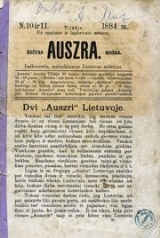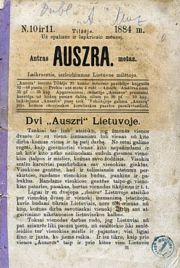
Aušra
Encyclopedia

Lithuania
Lithuania , officially the Republic of Lithuania is a country in Northern Europe, the biggest of the three Baltic states. It is situated along the southeastern shore of the Baltic Sea, whereby to the west lie Sweden and Denmark...
n newspaper. The first issue was published in 1883, in Ragnit, East Prussia
East Prussia
East Prussia is the main part of the region of Prussia along the southeastern Baltic Coast from the 13th century to the end of World War II in May 1945. From 1772–1829 and 1878–1945, the Province of East Prussia was part of the German state of Prussia. The capital city was Königsberg.East Prussia...
, Germany
Germany
Germany , officially the Federal Republic of Germany , is a federal parliamentary republic in Europe. The country consists of 16 states while the capital and largest city is Berlin. Germany covers an area of 357,021 km2 and has a largely temperate seasonal climate...
(newspaper credited it as ) East Prussia's ethnolinguistic part - Lithuania Minor
Lithuania Minor
Lithuania Minor or Prussian Lithuania is a historical ethnographic region of Prussia, later East Prussia in Germany, where Prussian Lithuanians or Lietuvininkai lived. Lithuania Minor enclosed the northern part of this province and got its name due to the territory's substantial...
. Later it was published monthly in Tilsit (present-day Sovetsk
Sovetsk, Kaliningrad Oblast
Sovetsk , known by its historical German name of Tilsit in East Prussia before 1946, is a town in Kaliningrad Oblast, Russia, located on the south bank of the Neman River. Population: -History of Tilsit:...
). Even though only forty issues were published and the circulation did not exceed 1,000, it was a significant event as it marked the beginnings of the Lithuanian national rebirth that eventually resulted in an independent Lithuanian State (1918–1940). This period, between 1883 and 1904, when the Lithuanian press ban
Lithuanian press ban
The Lithuanian press ban was a ban on all Lithuanian language publications printed in the Latin alphabet within the Russian Empire, which controlled Lithuania at the time. Lithuanian-language publications that used the Cyrillic alphabet were allowed and even encouraged...
was enforced by Tsarist authorities, has been referred to as the Aušros gadynė (the Dawn Period). Due to financial difficulties the printing was discontinued in 1886.
History
After the Russian authorities denied permission to publish a Lithuanian newspaper in VilniusVilnius
Vilnius is the capital of Lithuania, and its largest city, with a population of 560,190 as of 2010. It is the seat of the Vilnius city municipality and of the Vilnius district municipality. It is also the capital of Vilnius County...
, Jonas Šliūpas proposed to publish it in East Prussia
East Prussia
East Prussia is the main part of the region of Prussia along the southeastern Baltic Coast from the 13th century to the end of World War II in May 1945. From 1772–1829 and 1878–1945, the Province of East Prussia was part of the German state of Prussia. The capital city was Königsberg.East Prussia...
, Germany
Germany
Germany , officially the Federal Republic of Germany , is a federal parliamentary republic in Europe. The country consists of 16 states while the capital and largest city is Berlin. Germany covers an area of 357,021 km2 and has a largely temperate seasonal climate...
. However, he was perceived as too radical, and Jurgis Mikšas, the printer, invited Jonas Basanavičius
Jonas Basanavicius
Jonas Basanavičius was an activist and proponent of Lithuania's National Revival and founder of the first Lithuanian language newspaper Aušra. He was one of the initiators and the Chairman of the Organizing Committee of the 1905 Congress of Lithuanians, the Great Seimas of Vilnius...
to become its first editor. During its three years of existence, Aušra had a total of five editors. After Mikšas had to resign due to personal reasons, Šliūpas was entrusted to oversee future publications. However, he ran into conflicts with Basanavičius, who was living in Bulgaria
Bulgaria
Bulgaria , officially the Republic of Bulgaria , is a parliamentary democracy within a unitary constitutional republic in Southeast Europe. The country borders Romania to the north, Serbia and Macedonia to the west, Greece and Turkey to the south, as well as the Black Sea to the east...
. Šliūpas also had issues the German authorities due to his involvement in nationalistic movements and had to leave Prussia in 1884. The other editors, Martynas Jankus
Martynas Jankus
Martin Jankus was a Prussian-Lithuanian printer, social activist and publisher in East Prussia, called the Patriarch of Lithuania Minor. He was one of the publishers of Aušra, the first Lithuanian-language newspaper...
and Jonas Andziulaitis, did not engage in polemic writing and the controversies calmed down. Soon Mikšas ran into debt and could no longer support the newspaper. The printing was discontinued.
After Aušra was discontinued, new Lithuanian-language periodicals appeared. Varpas
Varpas
Varpas was a monthly Lithuanian-language newspaper published during the Lithuanian press ban from January 1889 to December 1905...
(literally: The Bell) was a secular newspaper, while Šviesa
Šviesa
Šviesa or Szviesa was a short-lived Lithuanian-language newspaper printed during the Lithuanian press ban in Tilsit in German East Prussia and smuggled to Lithuania by the knygnešiai. The monthly newspaper was published from August 1887 to August 1888 and from January to August 1890...
was more conservative and was a religiously oriented publication.
The newspaper was published outside Lithuania proper because of the Lithuanian press ban
Lithuanian press ban
The Lithuanian press ban was a ban on all Lithuanian language publications printed in the Latin alphabet within the Russian Empire, which controlled Lithuania at the time. Lithuanian-language publications that used the Cyrillic alphabet were allowed and even encouraged...
that had been enforced by the authorities of the Russian Empire
Russian Empire
The Russian Empire was a state that existed from 1721 until the Russian Revolution of 1917. It was the successor to the Tsardom of Russia and the predecessor of the Soviet Union...
since the Uprising in 1863
January Uprising
The January Uprising was an uprising in the former Polish-Lithuanian Commonwealth against the Russian Empire...
. It was prohibited to publish anything in the Lithuanian language
Lithuanian language
Lithuanian is the official state language of Lithuania and is recognized as one of the official languages of the European Union. There are about 2.96 million native Lithuanian speakers in Lithuania and about 170,000 abroad. Lithuanian is a Baltic language, closely related to Latvian, although they...
using the Latin alphabet
Latin alphabet
The Latin alphabet, also called the Roman alphabet, is the most recognized alphabet used in the world today. It evolved from a western variety of the Greek alphabet called the Cumaean alphabet, which was adopted and modified by the Etruscans who ruled early Rome...
; the government wished to force the people to use Grazhdanka, a type of Cyrillic alphabet
Cyrillic alphabet
The Cyrillic script or azbuka is an alphabetic writing system developed in the First Bulgarian Empire during the 10th century AD at the Preslav Literary School...
. Printing in the Latin alphabet was organized abroad, mostly in Lithuania Minor; knygnešiai
Knygnešiai
Book smugglers were people who transported Lithuanian language books printed in the Latin alphabet into Lithuanian-speaking areas of the Russian Empire, defying a ban on such materials in force from 1866 to 1904...
(literally: book smugglers) would carry the printed materials across the German-Russian border. This was one of the ways Aušra would reach its readers. The other way was in sealed envelopes.
Content
More than 70 people contributed to Aušra. The writers, or Aušrininkai, came from families of well-to-do peasants that started to appear after serfdomSerfdom
Serfdom is the status of peasants under feudalism, specifically relating to Manorialism. It was a condition of bondage or modified slavery which developed primarily during the High Middle Ages in Europe and lasted to the mid-19th century...
was abolished in 1863. Most of the authors received education in the Russian universities and were fluent in Polish. Because of frequent changes in editorial staff, the newspaper did not have a clear and well-defined agenda. Basanavičius did not envision Aušra as a political publication; in the first issue he declared that the newspaper would deal only with cultural matters. However, Aušra soon took on a nationalistic agenda. Aušra helped to crystallize many ideas about the Lithuanian nation and the definition of a Lithuanian. It started to reject the ideas of resurrecting the old Polish-Lithuanian Commonwealth
Polish-Lithuanian Commonwealth
The Polish–Lithuanian Commonwealth was a dualistic state of Poland and Lithuania ruled by a common monarch. It was the largest and one of the most populous countries of 16th- and 17th‑century Europe with some and a multi-ethnic population of 11 million at its peak in the early 17th century...
. The authors started to think about an independent Lithuanian nation-state.
It published on many different subjects like agriculture or reports from Lithuanian communities in the United States
United States
The United States of America is a federal constitutional republic comprising fifty states and a federal district...
, but history was the most popular. The foreword of the first issue began with a Roman proverb
Proverb
A proverb is a simple and concrete saying popularly known and repeated, which expresses a truth, based on common sense or the practical experience of humanity. They are often metaphorical. A proverb that describes a basic rule of conduct may also be known as a maxim...
, Homines historiarum ignari semper sunt pueri, or People ignoring history remain children forever. They built upon the works of Simonas Daukantas
Simonas Daukantas
Simonas Daukantas or Szymon Dowkont was a Lithuanian writer, ethnographer and historian. One of the pioneers of the Lithuanian national revival, he is credited as an author of the first book on the history of Lithuania written in the Lithuanian language...
, the first historian, who wrote history of Lithuania in Lithuanian
Lithuanian language
Lithuanian is the official state language of Lithuania and is recognized as one of the official languages of the European Union. There are about 2.96 million native Lithuanian speakers in Lithuania and about 170,000 abroad. Lithuanian is a Baltic language, closely related to Latvian, although they...
and painted an idealized image of the mighty Grand Duchy of Lithuania
Grand Duchy of Lithuania
The Grand Duchy of Lithuania was a European state from the 12th /13th century until 1569 and then as a constituent part of Polish-Lithuanian Commonwealth until 1791 when Constitution of May 3, 1791 abolished it in favor of unitary state. It was founded by the Lithuanians, one of the polytheistic...
. Aušra maintained anti-Polish attitudes towards the Polonized
Polonization
Polonization was the acquisition or imposition of elements of Polish culture, in particular, Polish language, as experienced in some historic periods by non-Polish populations of territories controlled or substantially influenced by Poland...
Lithuanian nobility, but tried to avoid confrontation with Tsarist Russia in the hope that the press ban would be soon lifted.
The newspaper was directed at the intelligentsia and therefore limited its readership. The peasants did not appreciate that Aušra was secular and did not embrace Catholic traditions.

